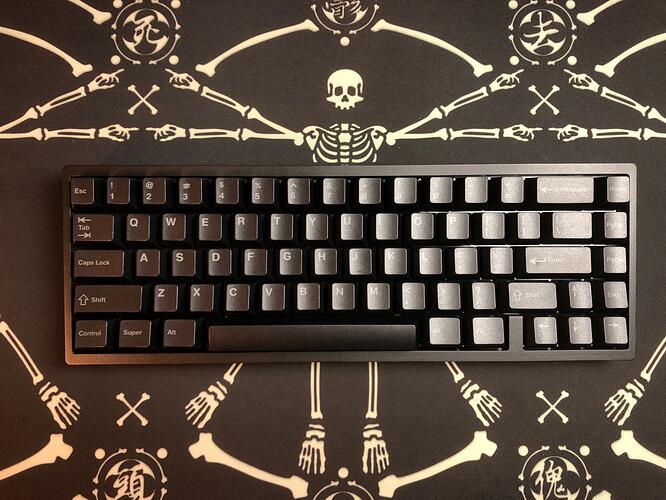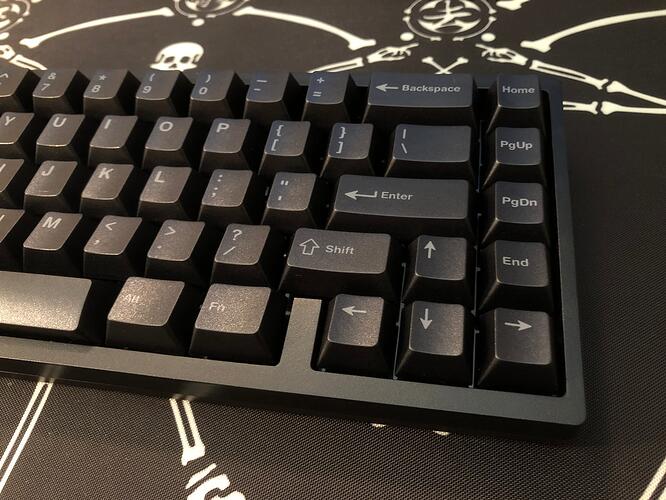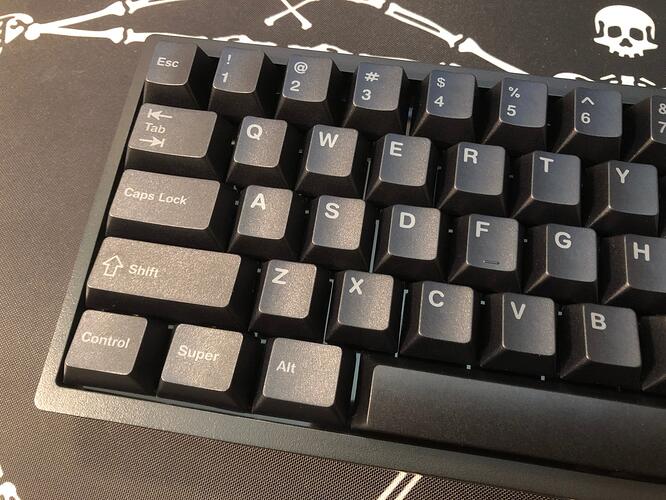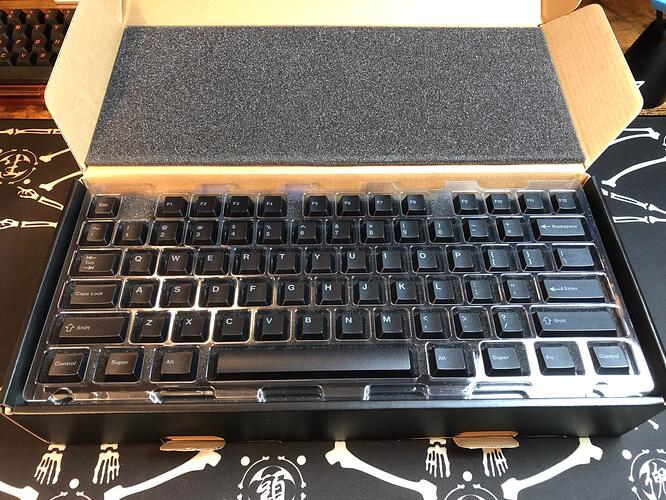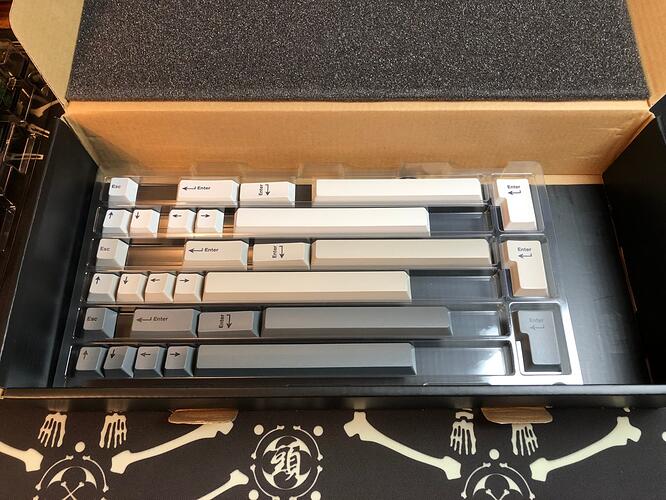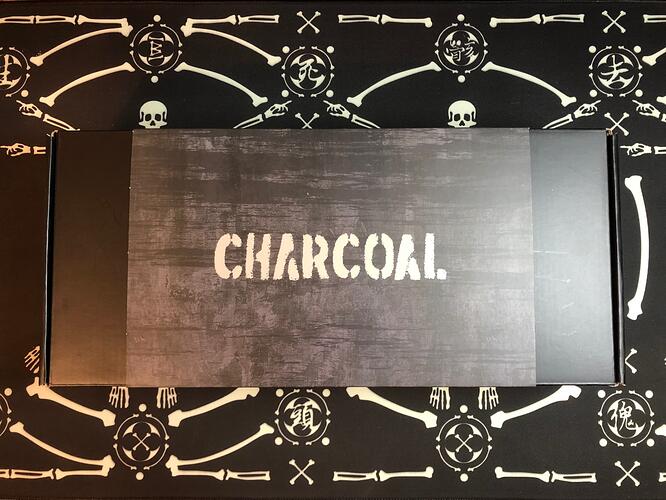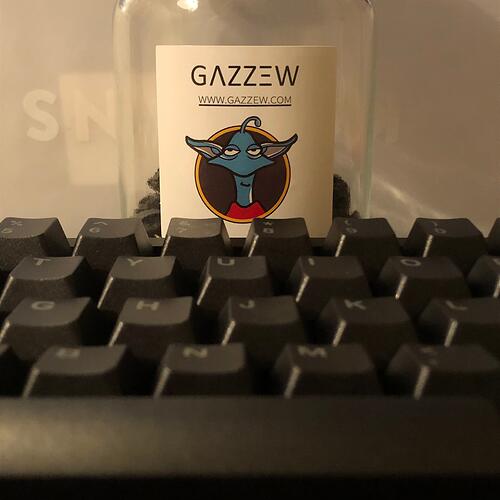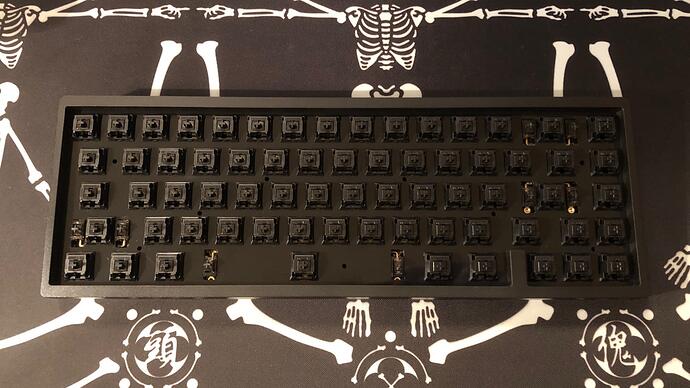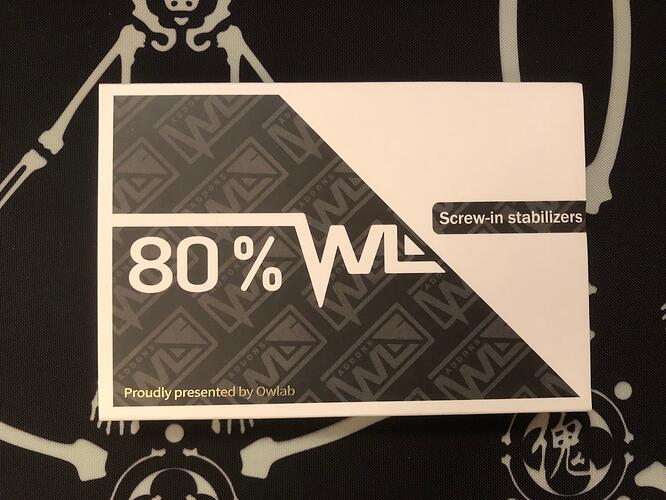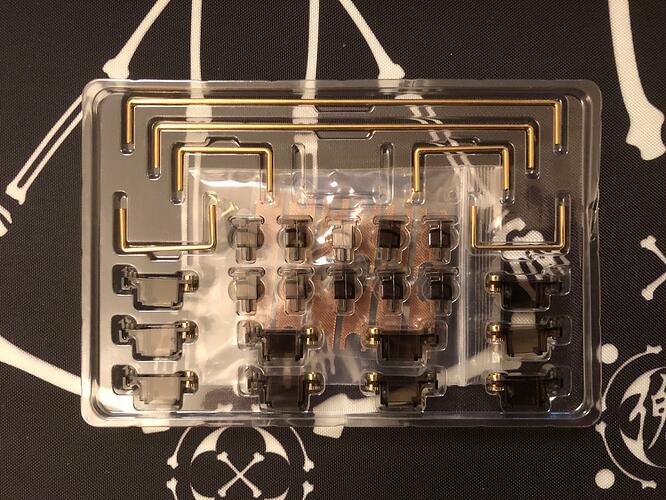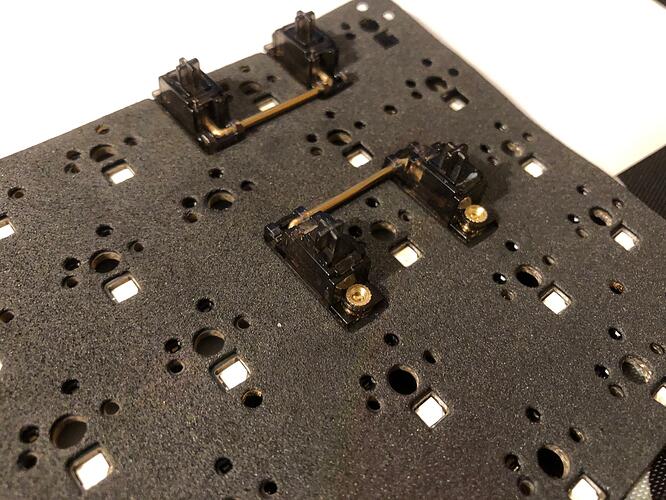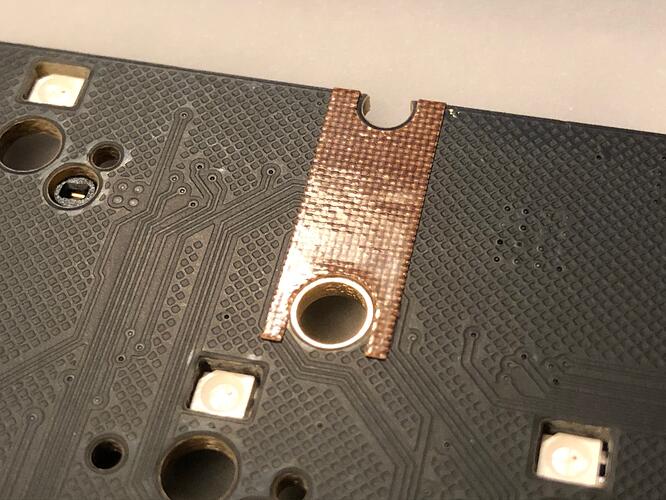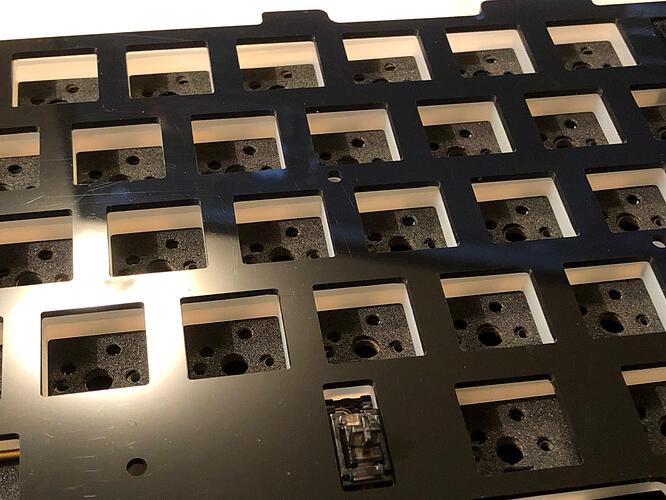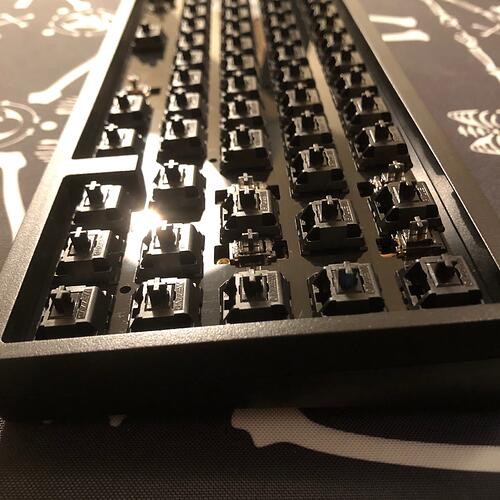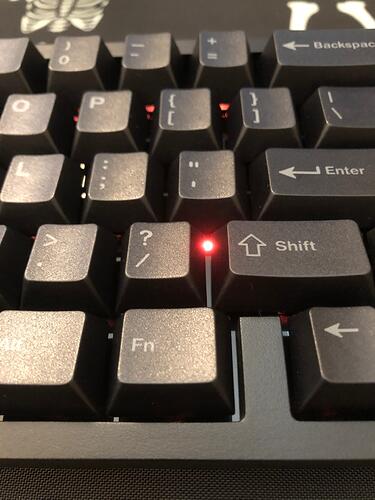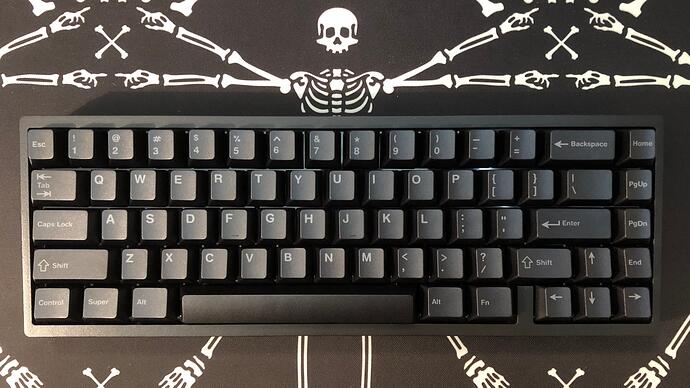Hello from the Spirit World…
All black everything:
KBD67 v3 | “Black on Black”
-
KBD67 MKII RGB V3 hot-swap PCB (thin pre-cut foam on top)
-
Black KBD67 Lite ABS case from R1
-
Boba Black U4T switches, stock
-
NK_ Charcoal PBT Cherry profile caps
-
Black BredWorks POM plate (standoffs omitted)
-
Smoky black Owlab Owl Stabs (tuned with 205g0, 206g2, and shim washers; rubber wire supports and PTFE/fiber tape omitted)
Initial impressions 
The keyset:
- Yo, @pixelpusher, I think you were asking about these
Material / feel:
So far these feel exactly like NovelKeys’ PBT Taro set, which is to say very good. They are nice and thick, and hey! The wide keys are flat. They have a very fine texture that I find very pleasant; like a worn, but not yet smooth stone.
They have that nice, solid, durable feel that good PBT caps are known for. The precious caution I can’t help but associate with ABS sets is simply a non-factor with PBT sets, and this one is no exception.
To continue the stone comparison, I’d say that’s where these sit on the spectrum of bone-dry and soft plastic. Dry, but not desiccated like some PBT sets.
I also appreciate that these don’t seem to have (or have a better) coating like many PBT sets do; it seems like that stuff just makes for a clammy and weird feeling that makes me want to wash my hands every few minutes. These I can just comfortably type on for hours and they still have that nice fresh feeling.
Fit:
Not a whole lot to say here but worth noting: These caps seem to have a nice, tight grip on the Bobas and Owl stabs, but I needed some PTFE tape when using them on older C3 Equalz stabs. Fit isn’t totally consistent but it leans on the tight side; I’d say at least above average consistency for a PBT set and well within the range of “good”.
Color:
The black of the NK_ Charcoal keys has a cooler color temperature (as in more blue) than the case, plate, or switches.
This is actually much easier to see in the photos than in real life: likely due to the very warm light of the incandescent lamp being exaggerated by the long-ish exposure of the shot, less of which is being reflected by the cool grey keys.
Nerd minutia aside; “charcoal” is an apt description of this set’s black, at least in terms of the tone and surface quality. The hue is more cool than natural coal, though. The black comes from reverse dye-sub on top of a cool middle-dark grey, which shows through as the legends and is visible on the bottom of the caps.
In the box:
Like the Taro version, this kit has lots of compatibility keys and even a few different colored accent sets. As-packaged, keys without homing elements are the default, with homing keys available as options in the bottom of the package.
Where GMK has a deeper scoop or bottom-bar as the two options, this manufacturer’s alternative to the homing bar is simply no homing at all. Aesthetically it’s very clean, but I’d find it pretty challenging to use, I think. The homing bars themselves are nice and subtle while being plenty easy to feel - pretty much “just right” IMO.
The box:
This set has the same style of packaging as Taro (and likely the rest of their PBT Cherry sets) - layers of thin plastic trays with troughs and a few wider spaces for ISO enters and such. The keys can slide around in these troughs, but each layer has foam on top so they don’t really move around that much - I didn’t see any damaged or scuffed keys.
A printed paperboard sleeve slides off of the featureless black cardboard box, which itself is on the big side. It does a fine job of protecting the keys though, so no complaints.
The switches:
Pretty darn good, as Gazzew stuff tends to be.
Sound:
Those with highly developed and exacting tastes may want to tune these, but I’d say their stock performance is in comfortably good territory. The springs come pre-dipped on the bottom, and there is a light sheen of oil on the stem legs to aid smoothness with the strong bump. I’m particular about my onomatopoeia and I generally would not call these “thocky” - though they are on the deep side for long-pole switches, I suppose. They have a tasty “percussive report” - how about that? It’s loud and crisp, but not quite so intense as to be piercing and falls just short of sharp.
You know, … clacky.
Feel:
The definition of “strong” tactility seems to get redefined every few months, but I think it will always be safe to say that U4Ts are nowhere near “gentle” - they’re in the realm of Holy Pandas and all the many adjacents. Compared directly with a heich pee, the you fore tee’s bump is more wide, and takes up even more of the travel. In normal typing, it’s all but impossible not to bottom these out, and that’s by design. You will clack these.
3DKeebs special edition:
Generally speaking, these are nearly identical to the pearl-and-mustard standard U4Ts, produced with the same tooling and given the same basic factory tuning. I think there are some slight acoustic differences with the black plastic vs the pearl, but I’d say it’s negligible.
The stabs:
I have mostly good things to say about these:
- Above-average smoothness even in [current year]
- Less rotation-play than many other popular stabs
- Wires seem good and reasonably straight
- Comes with plastic washers and pre-cut PTFE/fiber tape
- IMHO, way better than Durocks even with the caveat I’m about to mention
The caveat:
- These appear to either be meant for a PCB thinner than the KBD67 MKII, or there’s an engineering oversight that Owlabs needs to address: once clipped-in to the non-screw side, pulling the other side home causes the wire clip to open, effectively worsening the tolerances of the wire clip. This is proportional to thickness, so the included PTFE/fiber tape strips (which I wanted to use) make the issue noticeably worse.
I think this might explain some of the discussion I’ve seen about Owlstabs being hard to tune. When not mounted, the clip is nice and tight - but when screwed-in, there’s significantly more play. I think it would make sense for Owlabs to update these, either having multiple versions for specific PCB thicknesses, or maybe even using screws on both sides.
The plate:
I don’t think I’ve had enough time or used enough switches with it yet to have a developed opinion, but I will say that it has a well-balanced grip on the switches and appears to be of high quality. The cutting marks are clean and the surface is good.
It’s almost mirror-glossy piano black, meaning it looks stunning and luxurious until you touch it and leave a fingerprint, or wipe it with anything more abrasive than a cloud and leave some light scuffs. Pretty much nature of the beast with plastic like this, though - and not something you’re likely to see in use. The gloss finish is one I might not have chosen if given the option, but it does look really neat having that reflective shine on a black surface under the keys, making it look like they’re mounted on a marble countertop or something.
I haven’t done a side-by-side comparison yet, but so far this feels softer to me than all but the stock polycarb plates. I’ve heard POM is generally softer than PC in sheet form, though I’m pretty sure this sheet is thicker than either version of the stock KBD67L ones. Heck it, I’m tired of not being able to provide exact answers in these situations, I’m ordering a digital caliper b/c who knows when I’ll find the one I technically possess but have not seen in over a year
Since I elected not to use the standoffs between the plate and PCB, the RGB shows brightest through the holes intended for them.
Generally, this configuration makes for nice, understated shimmers below the keycaps.
The deskmat is from MelGeek, originally paired with the MG Mortal run.
Print quality is average, but the surface quality seems great. It’s a bit higher friction than I’m used to, which is good for me and my mild tremor - but it may annoy those that are used to gliding their mouse around. It’s a branded fabric called Cordura, used on all kinds of stuff including water-proof boots. It feels like I could spill my coffee on this, wash it, and no one would ever know - but I’m not going to test that.
Fabric quality is great in terms of feeling durable - but my mouse sometimes gets confused by the white parts of the print.
I’m not sure if some mouses are more susceptible to this than others, but all that I’ve owned have trouble on white surfaces. Just a little bit of visible variegation in the color works, though; say an image of old paper texture or close-up photo of a dirty bone - both are white-ish, but the non-uniformity of the light color is enough for the sensor to track.
The PCB:
I love this PCB, with one little-big asterisk. Little because it’s totally fixable by the user - big because it is decidedly not beginner-friendly, which I think hurts the product for one of its otherwise strongest demographics. Specifically, the V3 is not ready to go with VIA as the website claims - so doing anything including turning the lights off has a learning curve.
You have to manually load the .json into VIA every time, not just the first - and the documentation leads you to flashing the PCB before that. (This comes in the form of booting the keeb as a flash drive, deleting the existing .bin file, and replacing it with one downloaded from Google Drive.) To complicate things, the instructions for how to put the KBD6X PCBs into boot loader mode are incorrect in some of the documentation - it is not spacebar+B while plugging in the cable, it’s Esc while plugging in the cable.
So - if you’re new to all this, there’s like three solid layers of "WTF?" to wade through before you get to customizing your firmware settings and utilizing many of this board’s great features.
That one unfortunately-placed experience wrinkle aside, I really do think this is a great PCB. Once you get it talking to VIA (or QMK), remapping keys and creating macros are a breeze. Well. There’s a slight learning curve to the macros, but once you get it they’re simple and easy - and more importantly, they work. There are more layers available than I can ever imagine needing. It’s got RGB, it’s got hot-swap, it’s south-facing, it’s 67-key, it’s USBC, it fits in like five or six different cases - easily one of my favorite cores for 65% keebs.
Overall:
As a complete keyboard, this offers a snappy, high-tactile experience. Between the silicone feet and mounting system and the POM plate, this setup takes the edge off of what might be an otherwise harsh combination of switches and caps. I’d still say these switches are a bit much for my tastes, which I think comes down to how wide the U4 bumps are - but if big bumps are your thing is is a great way to enjoy them.
The blacked-out aesthetic has an understated if slightly menacing coolness. Since my very first one, I’ve always had black keebs in my collection that tended to be my daily drivers, and this setup would be a great candidate for that - though I might swap the switches for, say, TTC Matrix-01 Tactiles.
